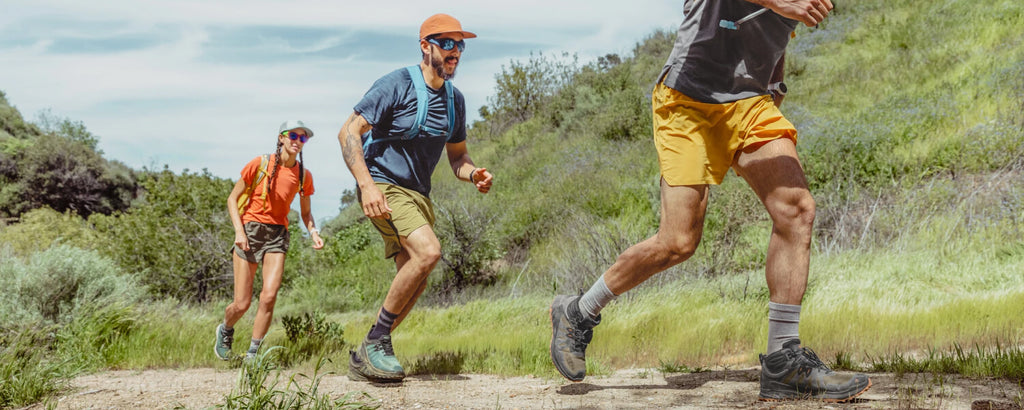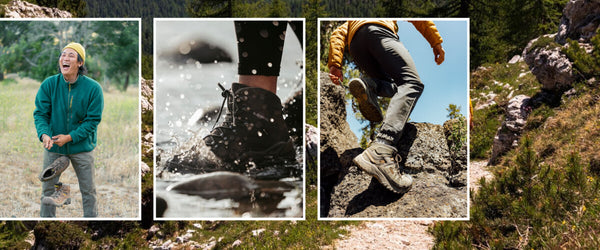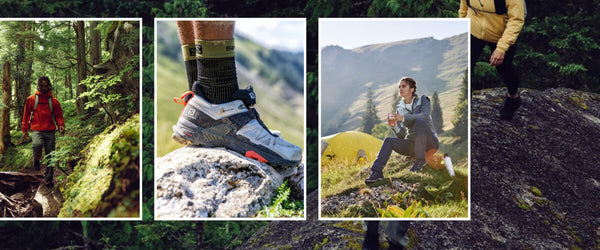
To help you make an informed decision, here are some key factors to consider when shopping for the best hiking shoes:
Terrain and Trail Conditions
The nature of the terrain you'll encounter is crucial in selecting the most appropriate hiking shoes. Consider whether you'll be hiking on rugged mountain trails, rocky terrain, muddy paths, or flat surfaces. Look for shoes with appropriate traction, support, and durability to match the conditions you'll encounter.
Hiking Shoe Type
There is a diverse array of hiking shoe styles available, including low-cut shoes, mid-cut boots, and high-cut boots. Low-cut shoes, exemplified by models such as the Salomon X Ultra 4 GTX Hiking Shoe, prioritize lightweight construction and flexibility, making them well-suited for day hikes and traversing easy trails. Mid-cut boots, like the Keen Circadia Mid Polar Hiking Boot, offer enhanced ankle support and stability, rendering them suitable for navigating moderate to challenging terrain. On the other hand, high-cut boots such as the LOWA Renegade II N GTX HI TF provide maximum ankle support and protection, making them the preferred choice for backpacking and trekking across rugged landscapes.

Fit and Comfort
Finding a hiking shoe that fits well and feels comfortable is paramount for preventing blisters and discomfort on the trail. Ensure that the shoe provides ample room for your toes to wiggle without feeling cramped, and that the heel is snug without slipping. Consider trying on shoes later in the day when your feet are slightly swollen to mimic the conditions of hiking.
Support and Stability
When selecting hiking shoes, prioritize those equipped with sufficient support and stability features to safeguard your feet and ankles against strain and potential injury. Look for attributes like cushioned midsoles, reinforced heel counters, and supportive arches, which are exemplified in models such as the Oboz Bangtail Mid Insulated Waterproof, Arc'teryx Acrux TR GTX Boot, and Keen Targhee II Waterproof. These features work to absorb impact and enhance stability, particularly on uneven terrain. Additionally, consider shoes with firm soles to bolster support, especially when carrying heavy loads or navigating rocky landscapes.

Waterproofing and Breathability
Depending on the weather conditions and climate of your hiking destination, waterproofing and breathability are essential considerations. Choose shoes with waterproof membranes such as Gore-Tex or eVent to keep your feet dry in wet conditions. Alternatively, opt for breathable materials such as mesh panels to allow moisture to escape and prevent overheating and sweat buildup.
Did you know? Gore-Tex was invented in 1969 by Wilbert L. Gore and Robert W. Gore, two American scientists, and has since revolutionized outdoor gear.
Durability and Construction
When purchasing hiking shoes, opt for ones crafted from premium materials and featuring robust construction to endure the demands of outdoor excursions. Seek out models such as the Salomon Quest Element GTX Boots, On Cloudrock Waterproof Hiking Boots, and Oboz Katabatic Low Waterproof, known for their durability and resilience. Prioritize shoes with reinforced toe caps and abrasion-resistant materials to shield against rocks and debris encountered along the trail. Additionally, thoroughly examine the stitching and bonding of the shoe to ensure longevity and durability, especially during prolonged use in challenging conditions.

Weight and Packability
Consider the weight and packability of hiking shoes, especially if you'll be carrying them in a backpack or luggage. Lightweight shoes are ideal for fast-paced hikes and reducing fatigue, while packable shoes take up minimal space and are convenient for travel. Strike a balance between weight and durability based on your hiking preferences and needs.
Break-in Period and Testing
Before hitting the trails, allow time to break in your new hiking shoes to ensure optimal comfort and performance. Wear them around the house or on short walks to gradually adjust to the fit and feel. Additionally, test your shoes on various terrains and inclines to assess their traction and stability before embarking on longer hikes.
By considering these factors and taking the time to find the best hiking shoes for your needs, you'll be well-equipped to tackle any trail with confidence and comfort. So lace up your boots, hit the trails, and immerse yourself in the beauty of the great outdoors.

FAQ
Sizing:
- How do I determine the right size for hiking boots? Determine your hiking boot size by measuring your feet using a ruler or Brannock device.
- Do hiking boots run true to size? Refer to the manufacturer's sizing chart for guidance, as sizing can vary between brands.
- Should I size up or down for hiking boots? Consider factors such as sock thickness and foot swelling when selecting the right size. It's often recommended to choose a size that leaves a little extra room for comfort.
- What factors should I consider when selecting the correct size for hiking boots? Read reviews from other customers to see if they mention anything about the sizing accuracy of the boots you're interested in.
Care Instructions:
- How should I clean my hiking boots? Clean your hiking boots regularly with a soft brush and mild soap to remove dirt and debris. Avoid using harsh chemicals or abrasive cleaners, as they can damage the material. After cleaning, allow your hiking boots to air dry naturally away from direct heat sources. Stuff them with newspaper to help absorb moisture and maintain their shape.
- How often should I waterproof my hiking boots? Apply a waterproofing treatment to your hiking boots periodically to protect them from moisture and prolong their lifespan. Follow the manufacturer's instructions for best results.
Durability:
- How long do hiking boots typically last? The lifespan of hiking boots depends on various factors, including frequency of use, terrain, and maintenance. Quality hiking boots can last anywhere from 500 to 1,000 miles of hiking.
- Are there any signs that indicate when it's time to replace my hiking boots? Signs that it's time to replace your hiking boots include visible wear and tear, loss of traction, decreased support, and discomfort or pain while hiking.
- How can I extend the lifespan of my hiking boots? To extend the lifespan of your hiking boots, clean and maintain them regularly, store them in a cool, dry place, and avoid exposing them to extreme temperatures or harsh conditions.
- Are there any warranties or guarantees on hiking boots for durability? Check if the manufacturer offers a warranty or guarantee on the durability of their hiking boots, as this can provide added peace of mind regarding their longevity.









Leave a comment